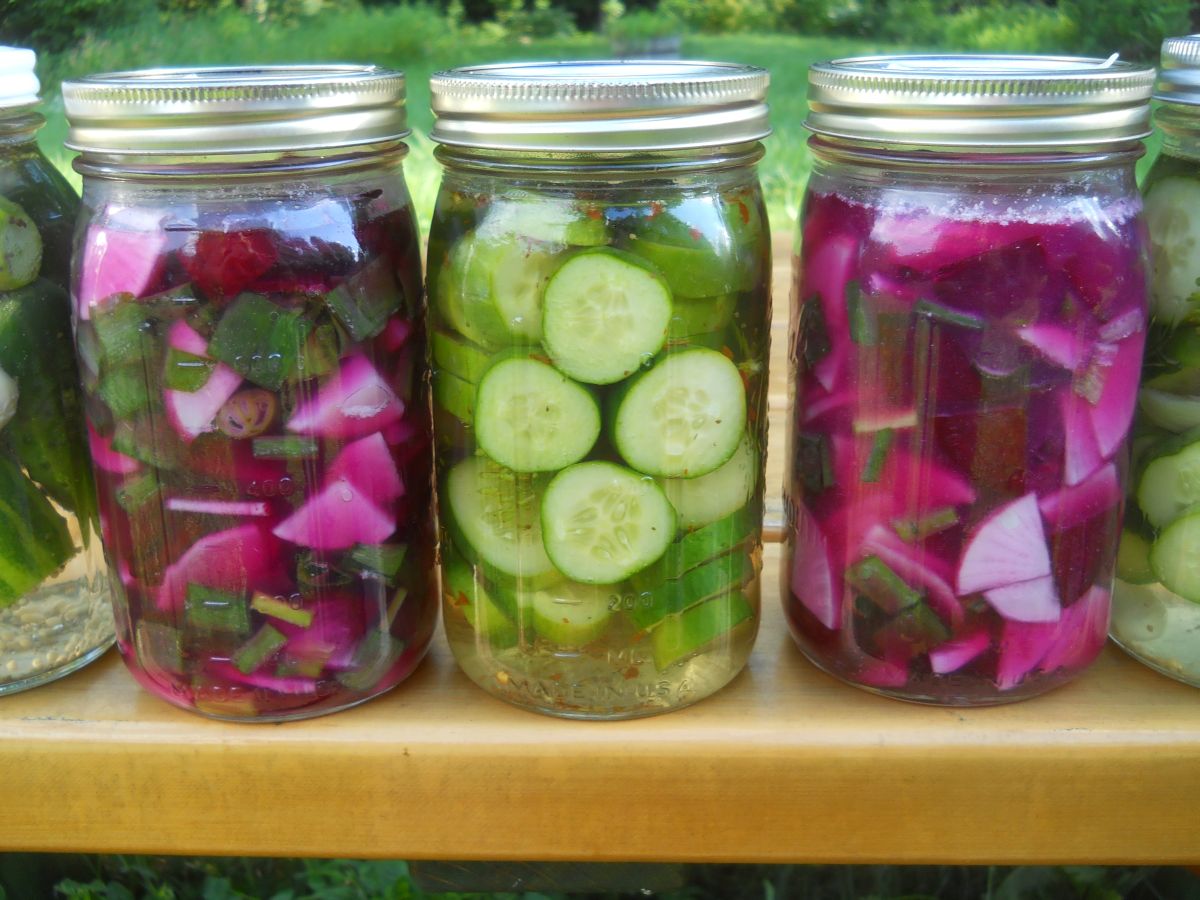Quick Pickling is The Easy Way To Make Pickles
I’m a farmer with a huge abundance of fresh veggies at my disposal. And one thing you might be surprised to learn about me is: I don’t can.
What do you mean? Don’t all farmers spend their summer months over a hot water bath processing dozens of jars of veggies?
Maybe many do, and I have in the past. Believe me I know what it’s like. It’s hot. It takes a big chunk of time. And over the years, I’ve found that I don’t like to do it.
Don’t get me wrong. The crunch of a cold pickle in hot summer is just about as refreshing as you can get. I love it!
But how can I get that familiar pickle flavor without standing over a hot stove canning?
That’s where “Quick Pickles” come in. Quick Pickles, also known as Refrigerator Pickles, are just that. Fast. Easy. And satisfyingly pickly!
And our recent Pickle-fest this weekend proves all three. Gene and I whipped out all three recipes below, multiple jars during my little one's nap (fast) without running to the store, canning or too much mess (easy). And the best part is the next day when our daughter broke into the jars (admittedly we couldn't wait the recommended at least 48 hours...) she LOVED them! And so did we! Satisfyingly pickly? Check!

What are quick pickles?
Quick pickles are vegetables stuffed into a jar and pickled in a liquid brine solution using a combination of vinegar, water, salt and/or sometimes sugar. They are stored in the refrigerator, rather than canned in a water bath. Quick pickles only require a few days in the brine before they can be enjoyed. If you are impatient (or your 2-year old is) you can even try them the next day! Quick pickles also tend to stay crispier than canned pickles because they’re not heated as long.
What are the benefits of quick pickling?
1. You can use it to pickle almost any vegetable.
This easy technique can be applied to many veggies throughout the garden season. Too many radishes or turnips? Quick pickle them. Too many beans? Quick pickle them. Red onions, carrots, beets, oh my! Etc. Etc. Etc.
2. You can make them with ingredients you likely already have in your kitchen!
Use simple spices of your choice, water, vinegar, salt, lemon juice… It doesn’t have to be complicated to make delicious pickles!
3. They're versatile at mealtime.
Plus they go with almost anything and really help tie a meal together taste wise. Kinda blah dinner possibilities? Whip out your quick pickled red onions or salad turnips and jazz up an otherwise boring meal.
Just recently, all I had in my fridge was leftover rice and chicken. Ugh! Didn’t have time for much else for lunch. So I popped out some quick pickled spicy curried carrot rounds and voila! A delicious and satisfying meal quickly and easily!
4. You can make small batches.
Another benefit of quick pickling is you can make a small batch quickly without having to make a big fuss with canning equipment and doing a big batch to justify heating the water. You can literally just make one jar at a time.
Three ways to make quick pickles out of any vegetable
Here’s the basic process of making quick pickles:
(With specific recipes following)
1. Prepare your vegetables:
Slice your vegetables. Thin slices will pickle faster and are great for veggies like turnips, summer squash, radishes, red onions or carrots. I like to cut some things thicker like a ¼-3/8” slice for cukes. Or cut your cukes into spears and carrots into sticks. You can even do little pickling cukes, green beans, cherry tomatoes, garlic cloves, and hot peppers whole, uncut. It’s your preference!
2. Stuff in a canning jar, leaving about 1” of headroom at the top.
3. Add spices of choice. Get creative! Here are some ideas:
- Fresh herbs: dill, thyme, oregano, and rosemary
- Dried herbs: thyme, rosemary, oregano, or marjoram
- Garlic cloves or garlic scapes: whole, smashed for mild garlic flavor, or sliced for stronger garlic flavor
- Fresh ginger: peeled and thinly sliced or minced
- Whole spices: celery seed, mustard seed, coriander, peppercorns, red pepper flakes, cumin seed, coriander seed, ETC. or make it easy and use “pickling spice.”
- Ground spices: curry powder, turmeric or smoked paprika, ETC.
4. Pour over pickling option of choice (see below).
5. Refrigerate.
Store the pickles in the refrigerator. The pickles will improve with flavor as they age. You can taste them after 24 hours, but try to wait at least 48 hours before cracking them open. (I don’t blame you if you can’t!)
Storage note: These pickles are not canned. They can be stored in the refrigerator for up to 2 months. But there's little chance they'll last that long.
Quick Pickling Option #1: With Vinegar
(The easiest, no-fail choice with standard “pickle flavor”--and 2-year old preferred!)
For one quart of Basic Dill Cucumber Pickles:
- Chopped cucumber slices to fill jar
- 1-2 cloves garlic
- 1-2 dill heads, or fresh dill sprigs, or dill seed
- 1-1.5 cup water
- 1 cup vinegar (Clear vinegars like white vinegar, cider vinegar, white wine vinegar, or rice wine vinegar are good options.)
- 2-3 TSP sugar (or to taste, can add more if you want sweeter pickles)
- 2-3 TSP salt (or to taste)
Add cukes, spices, garlic to jar to about 1" from the top. Bring water, vinegar, sugar and salt to a boil to disolve. Remove from heat. Proceed with either hot or cold pack method.
To hot pack (makes them the quickest):
Pour over veggies in jar while still hot, filling to ½” from the top. Put on lid tightly. Let cool and refrigerate.
To cold pack (makes them a little more crunchy):
Let liquid cool and then pour over veggies in jar, filling to ½” from the top. Put on lid tightly. Refrigerate.
Quick Pickling Option #2: Lacto-Fermented With Salt Brine
(The most probiotic benefits, but most finicky choice.)
For 1 quart Spicy Cucumber Pickles
- 3+ cups cucumbers, ends trimmed
- 1/4 cup sliced onion
- 2 cloves garlic, quartered
- 1 hot pepper chopped, or ¼ teaspoon chili flakes
- ¼ tsp. celery seed
- 2 tsp salt
- 1+ cup water
Submerge cucumbers in ice cold water for 30 minutes unless using just picked cucumbers. Slice into 3/8 inch slices and pack into jar with the rest of the ingredients. Disolve salt into water to make brine. Pour over brine filling up to 1 inch from top of jar. Put lid on tightly, label, and leave out at room temperature for 24 to 48 or more hours, until you like the taste and crunch/texture of them! Then store in the refrigerator and start eating! These will keep for 1-2+ months in the fridge.
Fermented Pickles can go by really fast so you should check them often as they are fermenting at room temperature. When it’s warm they can get mushy quickly, especially, so watch for this! If your batch does get mushy, just strain and blend them up into a pickle relish, store in the fridge and enjoy.
Quick Pickling Option #3: With Lemon Juice
(An uncomplicated, salt-free, vinegar-free alternative.)
For 1 quart of Lemon Dill Pickles
- Cucumbers, sliced or left whole if small picklers
- Dill heads, fresh sprigs of dill or ¼ tsp dill seed
- 1-2 cloves garlic
- ½ cup fresh squeezed lemon juice
- water to cover
Pack cukes and spices into jar leaving approx 1” head space. Pour lemon juice into jar and then cover with water up to ½” of top. Seal and refrigerate.
What do you think? Will you try it out to see how easy it is? Comment and let me know!



Add new comment
Comments (1)
Option #1 Quick Pickle
Sat, 2022-08-06 16:31